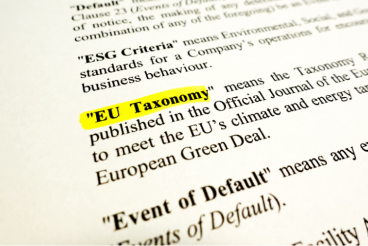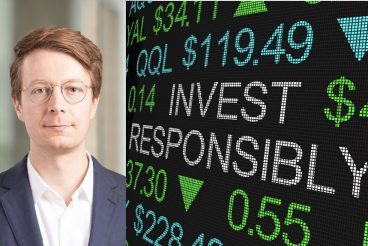This article is from VitalBriefing’s Sustainability Matters content series, in which we speak with experts across every facet of sustainability, ESG, sustainable finance, impact investing and more. If you or a colleague are interested in participating in the series, please get in touch by emailing eschrieberg@vitalbriefing.com.

In this second of a two-part interview with VitalBriefing – read Part 1 here – sustainability-reporting expert Richard Howitt explores the complex transition to sustainability by Europe’s finance industry. Will the EU’s incoming Corporate Sustainability Reporting Directive launch the sea change its proponents promise — or be held back by various complications?
Is greenwashing a significant problem in the financial and corporate spheres? Or is it due to the lack of uniform standards? Can the EU’s Sustainable Finance Disclosure Regulation enforce greater care and accuracy in sustainability reporting?
Based on my experience chairing global sustainable investment conferences, it does indeed feel like the exponential rise in ESG investment is going to be subject to far more scrutiny and accountability in the months and years ahead.
The investors I work with believe there may even be a ‘shake out’ in the ESG sector in the near future. They point to recent headlines such as the controversy over statements by the global head of responsible investing at HSBC’s asset management division downplaying the impact of climate change that led to his resignation, the recent regulatory action against Germany’s Deutsche Bank concerning alleged false ESG claims, the hard questions being asked about Tesla’s treatment of its workers, and the de-listing of no fewer than 1,200 investment funds by Morningstar from its sustainable investment list.
My own take, however, differs slightly. I attribute the temporary drop in ESG funds that we’ve seen in 2022 mostly to over-reliance on technology companies. To me, this trend is actually part of a ‘maturing’ of the ESG market, which will ultimately help make it more sophisticated and robust.
It can’t be denied that legislation for investor disclosure — including Europe’s Sustainable Finance Disclosure Regulation — is transforming the landscape across the whole investment community. No investor wants to be subject to regulatory penalties for non-compliance, not least for reputational reasons.
A bigger risk, though, as ESG becomes mainstream, is that investors will be left behind if they’re slow in embracing the new world of ESG — especially as younger generations with increasing purchasing power demand more focus on sustainability.
Many critics doubt that the sustainable investment industry can significantly impact emissions and climate change, especially because different labelling of financial transactions doesn’t affect where funding is channeled. Are they right?

Frankly, I believe any attempt to blame definitions and labels for a shortfall in generating sustainable finance is no more than an excuse. Sustainability standards and taxonomies may not be perfect, but they are good enough. The real issue is one of intention and will.
A clear example of this can be found by digging a bit deeper into the disjunction between the many estimates made within the sector.
For example, there is clearly a disconnect between estimates for the growth of ESG investment — said to have passed $1 trillion last year and poised to represent one-third of global assets under management (AUM) — and how far that investment is actually delivering on climate or Sustainable Development Goals (SDGs).
Meanwhile, the Organisation for Economic Co-operation and Development (OECD) estimates that private climate finance is static at around $14bn over the past five years. Yet, the ‘Capital as a Force for Good’ report suggests total climate-related financing has grown to well over $500 billion. That’s a pretty massive difference.
In terms of need, the International Energy Agency estimates that an additional $2 trillion, or more, is needed to fund the climate transition. Yet the SDGs alone are said to require $5-7 trillion annually.
I don’t apologise for pointing out these discrepancies because they illustrate the scale of the problem, especially if we are to succeed in mobilising the necessary funds to meet the challenge.
That’s why the Glasgow Financial Alliance must succeed. Representing $130 trillion AUM, the initiative launched at last year’s COP26 has the scale necessary to deliver, and all eyes will be on its success in doing so.
Are European and global sustainability ambitions at risk from rising energy costs and shortages, in part linked to the war in Ukraine, which is prompting a rethink, at least in the short to medium term, of the future of nuclear energy and natural gas, and even coal? Is the value of the EU’s taxonomy endangered by the dispute over the role of nuclear and gas power?
I’m worried that in the wake of Russia’s invasion of Ukraine, anxiety around energy security and cost are leading some countries to introduce new subsidies for, and to seek new sources of, fossil fuels.
The cost of renewables, however, has already undercut oil and gas. Ultimately, the rate of increase is an issue of cost — and simple economics suggests that the longer-term effect of high oil costs will be to engender a huge boost to demand and supply of renewable energy.
No-one should mistake public scrutiny of environmental claims and actions as a hindrance to achieving our aims. Rather, it strengthens our ability to achieve them.

What role should sustainability rating providers play? How should they be regulated? Is there a danger of dominant professional services groups establishing a similar stranglehold on sustainability measurement, assessment and reporting as they do in the financial accounting and audit field?
Let me preface by saying that there are many good people working at sustainability credit ratings agencies and data providers. That said, it’s hardly ideal that a single company can get markedly different scores according to different ratings.
The hard truth is that the agencies themselves are commercial entities. They simply do not have the same incentive towards transparency as non-profit sustainability standard-setters, which exist for the public interest.
And the same could be said of professional services firms, despite the fact that serving the public interest is integral to the role and training of an accountant. And I should know, considering that I led an organisation where the catchline was: “Accountants can save the world.”
What sets the European Directive apart, though, is that it identifies detailed competencies for auditing sustainability reports. Furthermore, it is explicitly states that these audits will not necessarily be done by accountancy firms with pre-existing relationships to the organisation being audited, but potentially by a range of providers.
I see this as a challenge to the accountancy sector. They have to step up.
Unfortunately, it’s clear that the multitude of credit rating agencies have contributed to the fragmentation of sustainability information. They need to adopt the new standard-setting initiatives in their methodologies if the demands for consistency, comparability and coherence in sustainability reporting are to be achieved.
The Paris Agreement set a goal of limiting global warming to 1.5ºC above pre-industrial era temperatures. With scientists now increasingly believing that target will not be met, and that the threshold could be reached this decade, is there a need to reset international targets and ambitions?
The problem with any variation from the 1.5 degrees target is that it represents a tipping point for climate change — crossing that bridge ushers catastrophic consequences.
Allowing it to slip to 2 degrees would, according to the Inter-governmental Panel on Climate Change, expose 1.7 billion people to severe heatwaves, destroy 99% of coral reefs, wipe out pollinating insects needed for agriculture across widespread areas, bring desert to the Mediterranean, destroy the Greenland ice sheet and add 10cm to sea levels.
There is a clear and direct link between every cumulative failure in mitigating climate change and the correlated adaptation that will be required as a result — and it can be measured by the resulting human, ecological and economic cost. Why, then, when it’s clear that we have the resources and can develop the technology necessary to succeed, would we not put every effort in to doing so?
If there were to be any change in targets and ambition, I would expect (hope?) such a shift to be in the ‘right’ direction beyond ‘net zero’. Ideally, the global economy would embrace the concept of regenerative economics so that we can focus on restoring and building natural and social ‘capital.’
Such a transition would see companies move beyond individual benchmarks, instead recognising that there are planetary limitations that are being breached, such as in biodiversity. Crucially, business and investment actions would then be measured within the context of collectively respecting and restoring activity to within these global boundaries.
This can restore financial capital, too — or it will jeopardise it. That’s our choice.
— — —
Richard Howitt is Senior Associate at the public interest law firm Frank Bold LLP and Strategic Advisor, Corporate Responsibility and Sustainability, Business and Human Rights. Richard was previously Chief Executive Officer of a forerunner body which is now merged to form the International Sustainability Standards Board and served for 22 years as a Member of the European Parliament, responsible for the EU’s first legislation on corporate sustainability reporting.





